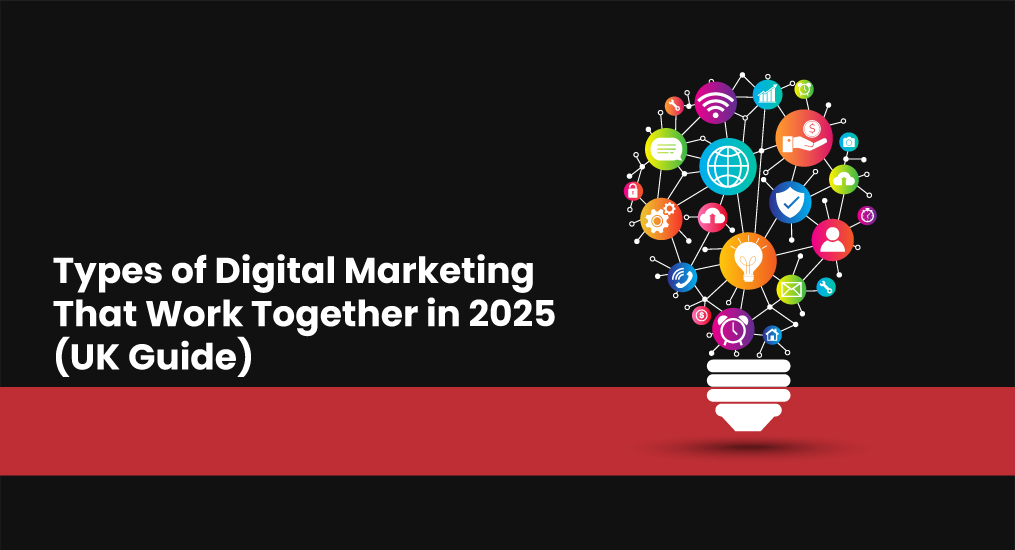You started with ads because they sounded like the fastest way to bring in new business. You chose your platforms, set your budget, and launched your campaigns. Maybe they brought in clicks and spiked the traffic for a bit. But the enquiries didn’t follow. Sales barely moved. And now you’re left wondering where your money went.
That’s the point where many business owners pause and ask the right question, not “Which ad should I run next?” but “What’s actually missing from this picture?”
Because digital marketing is about building a system that connects the dots. A system that helps strangers become visitors, visitors become leads, and leads become paying customers. Ads can support that process, but they can’t carry it alone.
If you’ve been running campaigns and getting little in return, chances are you’re relying on just one part of what should be a bigger system. At that stage, it often makes sense to hire professional marketers who can look at the whole picture and design a system that works together instead of in isolated pieces.
Let’s break down what that system looks like.
When Ads Feel Like a Waste
Advertising has its place. It can give you reach, visibility, and speed that other channels can’t always match. But by itself, it doesn’t build relationships, meaning it doesn’t give people a reason to trust you.
Here’s what usually happens: a visitor clicks your ad, lands on your site, and leaves. Not because you don’t have a good product or service, but because the rest of the journey wasn’t ready for them.
They didn’t get to know your brand. They weren’t offered something useful. Those weren’t followed up with or nurtured. And so, they moved on.
That’s not a failure of advertising. It’s a failure of structure. That’s where understanding the different types of digital marketing becomes so important. Across different regions, the priorities and habits of customers shift. What works well in one market can fall flat in another, and that’s especially true for businesses doing digital marketing in the United Kingdom markets, where audiences often expect a more joined-up experience before they’re ready to commit.
The Core Types of Digital Marketing in 2025 (and How They Work Together in the UK)
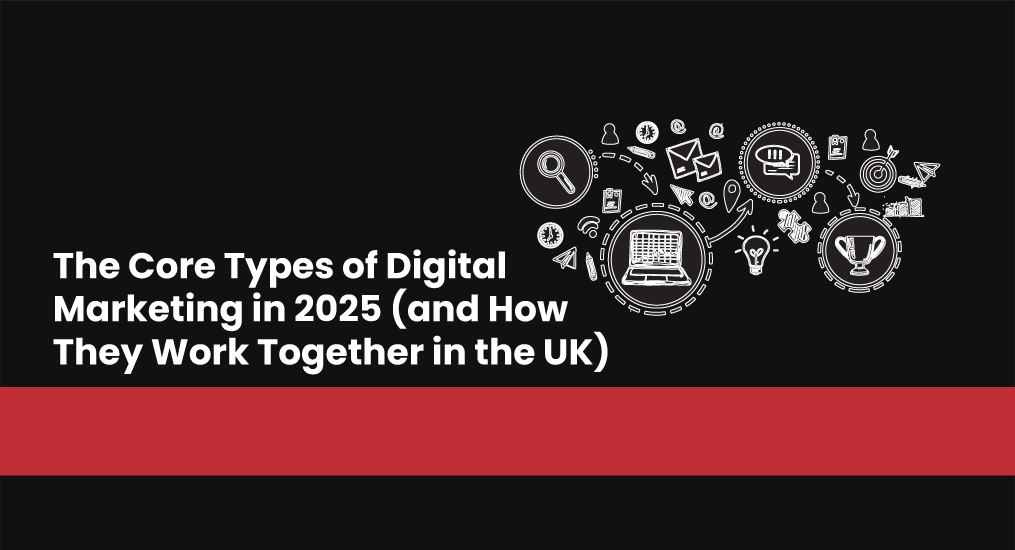
When you look at the types of digital marketing available today, each one serves a specific purpose. Some create awareness, build authority. Some generate leads, while others focus on trust or retention. The power is in how they work together, not just what they do in isolation.
Here they are:
Content Marketing for UK Businesses: Building Authority Before You Ask for Attention
Content is often the first real introduction someone has to your business. It shows up when they’re searching, when a friend shares it, or when they land on your site for the first time. Good content answers questions and helps your audience feel like you understand their world. It positions you as someone who’s already adding value even before money is mentioned.
That could be a step-by-step guide that walks them through a problem, a real example of how you solved a customer’s challenge, or a before-and-after comparison showing how different their business would be with you. Anything that makes the change obvious and leaves them better informed, more confident, and ready to act.
In 2025, this matters more than ever. Buyers don’t want to be sold to. They want to understand, compare, and decide in their own time. If you’re the one giving them the clarity they’ve been looking for, you’re the one they’re likely to trust.
SEO (Search Engine Optimisation): Being Present When People Are Already Looking
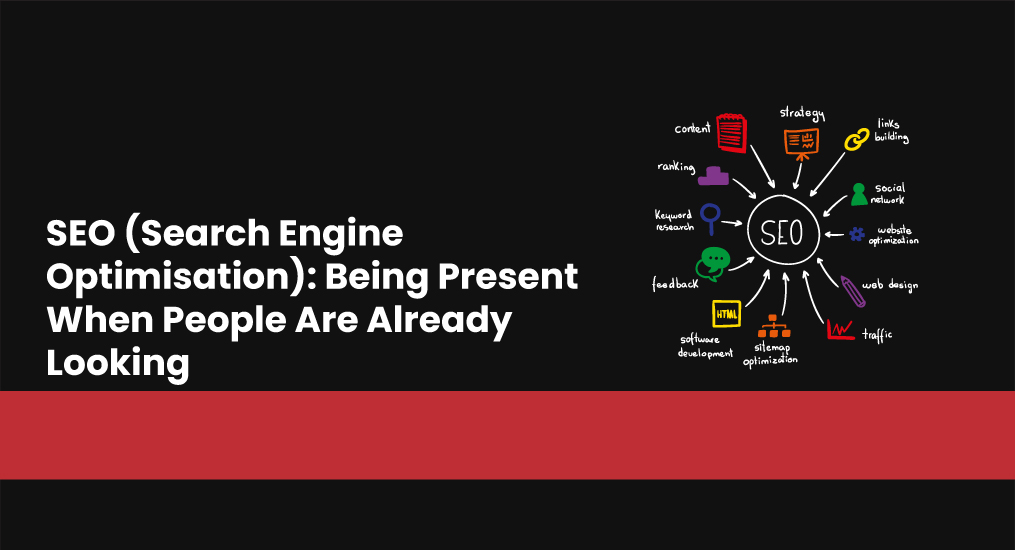
Search engines are still where intent lives. If someone’s typing into Google, they’re already halfway down the path of solving a problem or making a purchase. SEO is how you make sure your business is there when that moment happens.
SEO is about understanding the words your customers use and the questions they ask when they’re searching online. That could be someone in Cambridge looking for a local supplier, or a start-up in Silicon Fen comparing services before making a big decision. When you know their language and their intent, you can create pages that meet them at that exact moment and give them the clarity they were hoping to find.
In 2025, with AI-driven search experiences becoming more common, visibility depends not just on keywords, but on clarity, depth, and actual usefulness. This is especially true in competitive hubs like Silicon Fen. Businesses making use of digital marketing services in Silicon Fen, Cambridge, often gain a local edge because they understand both the tech-driven culture and the regional market dynamics.
Email Marketing: Staying Relevant After That First Spark
Someone visits your site and takes that first step, they download a guide, sign up for an offer, or send an enquiry. At that moment, they’ve shown interest, but they’re not ready to buy. If you leave it there, they’ll likely forget about you by the time they are ready.
Email marketing bridges that gap. It keeps the conversation going without relying on them to come back on their own. Through timely and relevant messages, you can answer their questions, share useful insights, and build familiarity over time. This steady contact makes it easier for them to choose you when the decision point arrives. For many businesses, this is the difference between being remembered and being replaced by the next search result. We’ve seen it time and again with companies doing digital marketing in the UK markets, where regular, relevant follow-ups often make the leap from initial interest to a confirmed sale.
For many businesses, it’s a crucial part of a digital marketing plan because it turns a single interaction into an ongoing relationship. Instead of chasing attention in crowded spaces like social media, email allows you to reach them directly, and in a place they check every day. If done well, it builds consistency, and consistency builds trust.
Social Media Marketing: Showing You’re Active, Human, and Worth Following
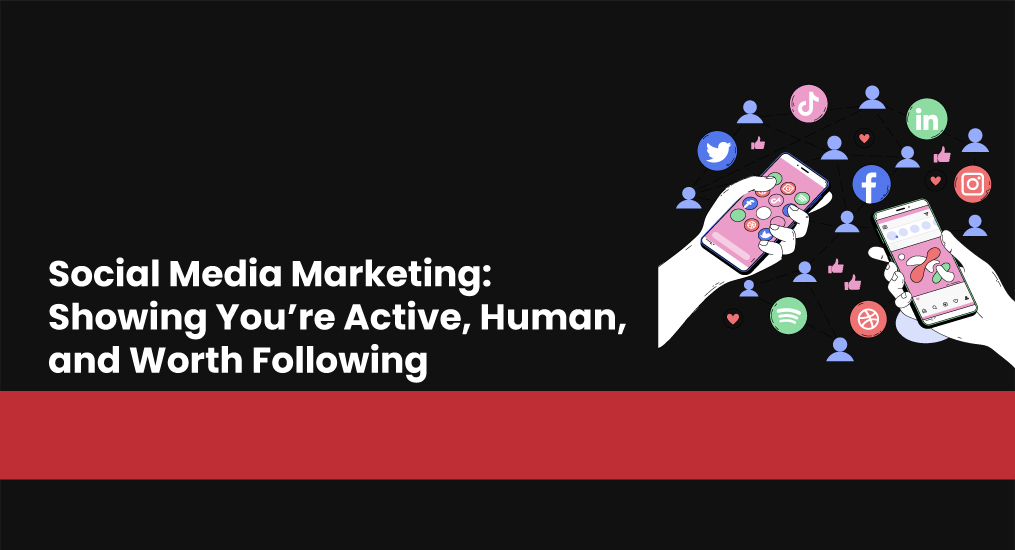
Social media does more than broadcast messages. It shows how you think. What you care about. How you respond. Whether you’re real.
It’s where people go to check you out. They don’t always follow. They don’t always like or comment. But they scroll, they skim, they form an impression.
In 2025, your social presence doesn’t need to be everywhere. But it does need to be alive. It needs to reflect your tone, your values, your voice. And it needs to be consistent enough that someone curious about your business doesn’t hit a wall of silence.
Organic social content gives shape to your brand. Paid social helps you reach new people. Together, they play a key role in keeping you visible and credible, especially when someone is comparing options.
PPC (Pay-Per-Click) Advertising: Speed, Reach, and Testing Grounds
PPC is where urgency and targeting meet. It gives you access to people you might never reach through organic channels alone. Whether it’s Google Ads, YouTube, or paid social, PPC allows you to be specific about the message, the offer, the audience, and the timing.
But it’s expensive when you’re not ready. If the landing page doesn’t load well, if the messaging isn’t clear, if the follow-up is missing, every click becomes a leak in your budget.
That’s why PPC works best when it’s part of a wider system. When you’re already capturing leads with email, already answering objections through content, already nurturing trust through reviews or case studies.
In 2025, with ad platforms becoming more automated and competitive, the businesses getting the best results are the ones combining paid reach with real substance.
Conversion Rate Optimisation (CRO): Making the Most of What You Already Have
You’ve done the hard work of getting people to your site. They’re clicking, reading, watching, even adding to their basket. But they’re still not converting. That’s where CRO comes in.
CRO is the ongoing process of making your site easier to navigate, your copy clearer, your offers more compelling, and your forms more usable. It’s less about “hacks” and more about removing friction, understanding hesitation, and helping people feel confident about moving forward.
In 2025, attention is thin, and patience is thinner. If something’s unclear or frustrating, people leave. Fixing that doesn’t require guesswork. It requires listening, testing, and adjusting with intention.
And when done right, CRO can double the return on every marketing pound you’ve already spent without having to drive more traffic at all.
Why Businesses in 2025 Can’t Ignore This Anymore
Each of these types of digital marketing plays a specific role. But together, they help you show up with relevance. They build authority. They stay consistent even when attention shifts. And they create an experience that makes someone feel like choosing you was the obvious next step.
What’s changing now is the level of expectation. Customers don’t need perfection. But they do expect clarity, trust signals, and a journey that makes sense. Businesses doing different types of digital marketing in United Kingdom can no longer afford to treat marketing as a bolt-on expense. It has to be part of how you operate.
And the good news? You don’t need to master every piece all at once. But you do need to understand how they connect and start building from there.
Why Most Businesses Only Use One or Two Types
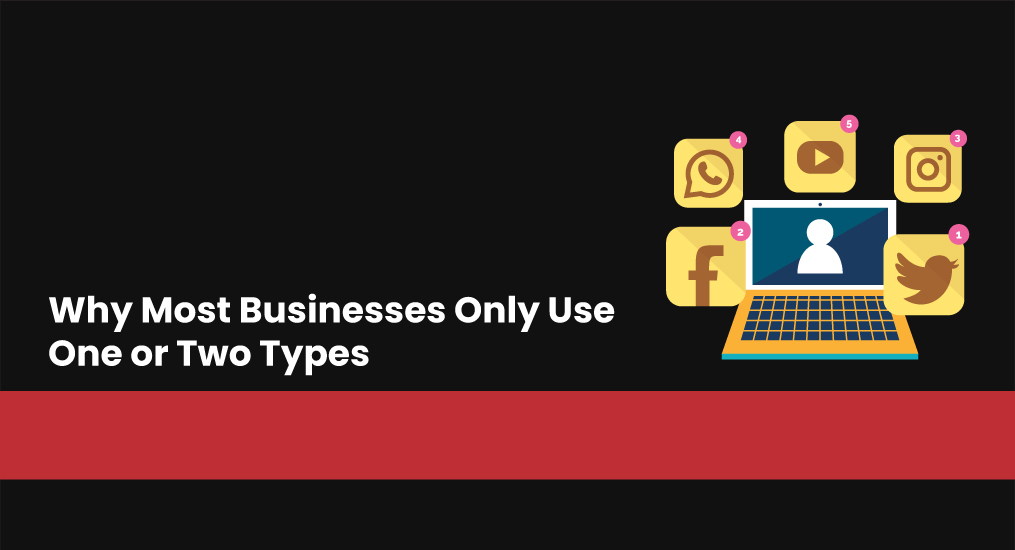
A lot of small businesses, especially those without a marketing department, stick to what’s quick. That usually means ads, boosted posts, or posting randomly on social media. These can feel productive, but they’re often disconnected. There’s no long-term plan, and the results are short-lived.
The better option is to step back and build a proper digital marketing plan. That means starting with a clear digital marketing strategy, one that focuses on your audience’s needs and aligns every channel you use with measurable goals. Not something overly complex or full of jargon, but something that gives structure to what you’re doing. A strategy that focuses on your customer’s journey and aligns the tools you use with the outcomes you want.
In our experience working with businesses doing digital marketing in the United Kingdom, the most common shift isn’t technical, it’s strategic. When people stop thinking in tactics and start thinking in systems, results improve naturally. This is becoming more visible among those investing in digital marketing in the UK, as they focus less on chasing one-off wins and more on building a clear, repeatable path from first contact to loyal customer.
A Simple Example of a Smarter Approach
Let’s say you run a local events venue. You’ve been spending on Instagram ads to promote your packages, but bookings aren’t coming in consistently.
Instead of doubling down on ad spend, you take a different path:
- You create a blog post that helps people plan their event timeline
- You include a downloadable checklist in exchange for an email
- Your emails share tips, inspiration, and testimonials over a few weeks
- You improve your enquiry page based on the questions people ask the most
- Then you run ads not to cold audiences, but to people who’ve already visited or signed up
You’re now using several types of digital marketing in one journey. And suddenly, the same budget gets you better results, not because you spent more, but because you connected the pieces.
This approach is common among businesses doing different types of digital marketing in the UK. But making it work takes more than just knowing the channels. It means understanding how each step fits together and how people here actually make decisions. That kind of joined-up thinking takes time, experience, and a lot of testing. Trying to manage it all alone can quickly become overwhelming, and the risk is spending more without seeing better results.
If you’re looking for digital marketing services in the UK, it helps to work with a team that knows how to build campaigns from real data and market trends. That’s why many businesses turn to Britechx Digital. They focus on connecting every part of your marketing so your budget stretches further without needing to increase spend.
Choosing the Right Mix for Your Business
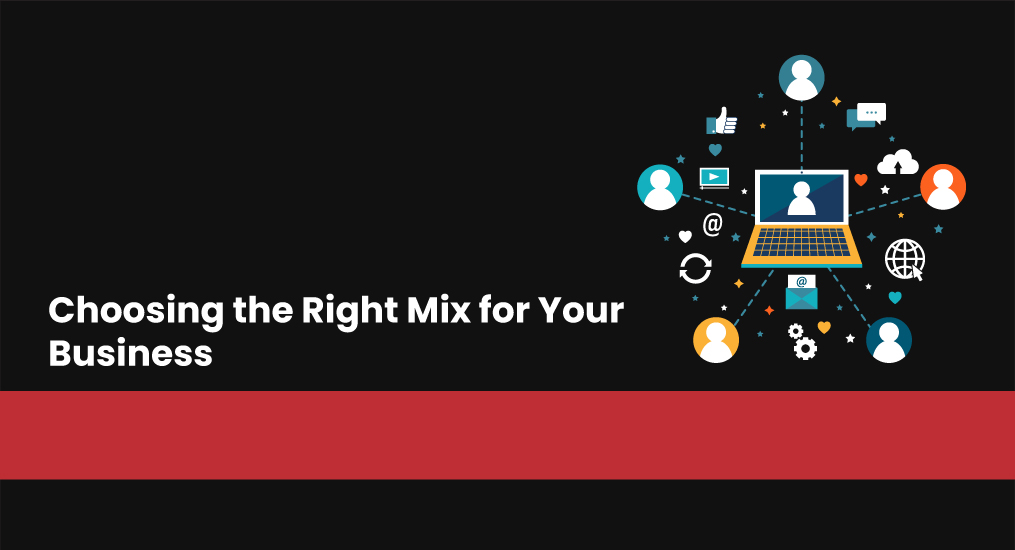
You don’t need to master every channel. But you do need to understand how they fit together. A small team might start with content, SEO, and email. A product-based brand might lean into PPC, retargeting, and conversion improvement. The key is matching the method to your audience and your goals.
If you’re feeling unsure where to begin, the best digital marketing company for you isn’t the one with the longest list of services. It’s the one that asks the right questions, helps you build a realistic strategy, and guides you through implementation step by step. You can explore exactly what that looks like by checking our marketing services page, where we break down the different ways we help businesses put these ideas into action.
Why This Matters Now More Than Ever
There’s a lot of noise out there. Ads are getting more expensive. Attention spans are shrinking. And platforms change their rules constantly.
But some things stay consistent. People still want to feel informed, understood, and supported before they make a decision. When you build your marketing around those needs, not just the algorithm of the month, you create something that lasts.
That’s one of the most overlooked advantages of digital marketing. It doesn’t just drive clicks or conversions. When done well, it creates a long-term asset that brings in leads even when you’re not actively spending.
It’s also one of the reasons digital marketing in the UK is becoming more strategic. Businesses here are starting to move away from random activity and towards smarter systems. And the ones doing it well are often the ones growing steadily, even in uncertain times.
If ads have burned you, you’re far from alone, because most business owners run into that moment where the spend feels heavy, the returns feel light, and the numbers don’t add up. That doesn’t mean digital marketing is broken, though. More often, it’s a sign you’ve only seen the shallow end of it, the quick wins and one-off tactics that don’t have the rest of the system holding them up.
That’s why it’s worth stepping back and looking at the entire journey your customers take, from the first time they hear your name to the moment they decide to act. Somewhere along the way, there may be gaps that slow them down, questions that go unanswered, or moments where interest fades.
Filling those gaps isn’t about doing more of the same; it’s about layering the right pieces in the right order. When you bring in the types of digital marketing that work together, each one playing its part in building trust, keeping attention, and making the next step easy, you turn scattered activity into a connected experience.
Once you’ve felt that shift, where every part of your marketing supports the next, it changes how you work. And it’s hard to imagine ever going back to the old way.
Frequently Asked Questions
What is ROI in digital marketing?
ROI, or Return on Investment, measures how much profit you make compared to what you spend on marketing. It helps you see which campaigns are paying off, so you can focus your budget on what works best.
What does CPC stand for?
CPC means Cost Per Click, which is the amount you pay each time someone clicks on your ad. It’s a handy way to keep track of how much you’re spending to get people interested in your business.
What is SEO in digital marketing?
SEO, or Search Engine Optimisation, involves making changes to your website so it appears higher in search results naturally. It’s about making your site easier for search engines and users to understand, which can bring more visitors over time without paid ads.
What is a KPI in digital marketing?
KPI stands for Key Performance Indicator. These are specific numbers or metrics you track to judge how well your marketing efforts are doing against your goals. For example, a KPI could be how many people sign up to your newsletter or complete a purchase.
What is CTR in marketing?
CTR means Click-Through Rate, which shows the percentage of people who see your ad or link and then click on it. It gives you a quick sense of how appealing your message or offer is to your audience.

